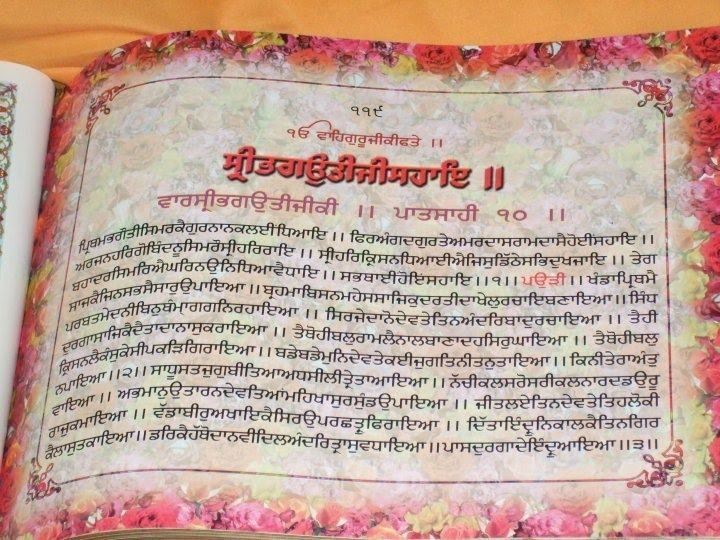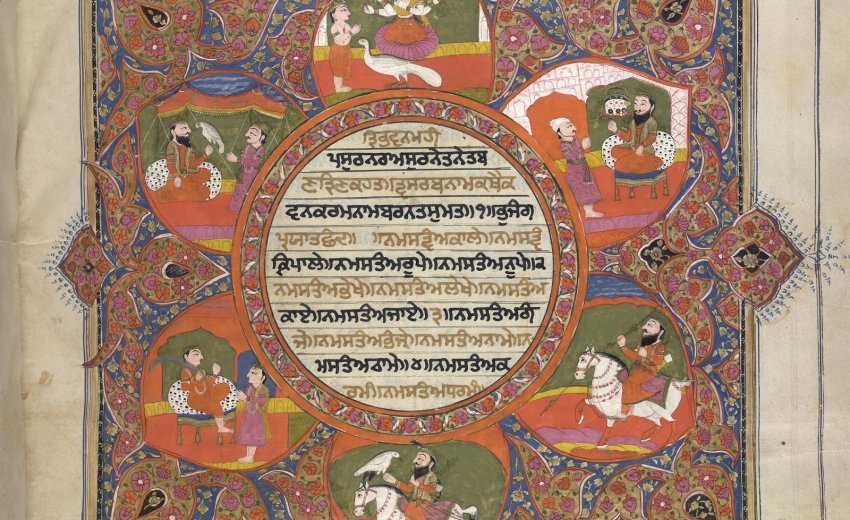Book Review
Sri Dasam Granth Sahib by G.S.Mann and K.Singh

What a worthwhile read!!!!!!
A new book on the Sri Dasam Granth Sahib by G.S.Mann and Kamalroop Singh reveals not only more about the history and compilation of this Sikh scripture but also shows rare images of the earliest rare manuscripts (pothis) of the Granth. The 50 Q and A (question and answers) book reveals the purpose and reasoning behind why Guru Gobind Singh created a complimentary scripture to the Guru Granth Sahib (SGGS). Guru Gobind Singh Ji proclaimed the SGGS as the Living Guru. After going through the book written in English gives an insight into the breakdown of the terms used in Dasam Granth; for example Charitrapakhyan means stories heard from others or from old tradition; there are over 450 stories based on the characteristics of human beings (strategy and human instincts); very interesting stories indeed but this is subject to criticism.
Extensive research over the last 10 years has contributed to such a unique piece of work as each word is loaded with deep meaning. It also gives an insight where certain sacred or philosophical statements is embed in the Granth such as mitar pyare nu from Shabad Hazare and manas ki jaat sabhai ekai pachanabo (man's caste should be recognised as one) from Akal Ustat. The final message is about the path of warriorhood (vir ras) and become a karma yogi or shant ras (peaceful) It is about recognising people of different denominations, religions and caste as one, one of acceptance and love.
Sri Dasam Granth Sahib is the second sacred scripture of Sikhism after Guru Granth Sahib. This book gives a complete understanding of the history, compilation and relevance of Guru Gobind Singh's compositions. In recent years many fallacies and misinterpretations have crept into the study and understanding of the scripture. Traditionally, Sri Dasam Granth Sahib is always present at Takhat Sri Hazur Sahib, Nanded and Takhat Patna Sahib, Harimandir Sahib, Patna, Bihar.
Two Sikh scholars, Gurinder Singh Mann and Kamalroop Singh, both from the UK have spent many years searching for the historical basis of the Granth, the earliest manuscripts, and the accepted ideologies of the Tenth Guru's Granth. Gurinder started researching Sikhism and particularly this scripture as early as 1997 as part of his MA, and his essays and presentations have been quoted and are widely recognized as some of the best work in the field of Dasam Granth studies. Kamalroop's revolutionary Phd has given the first account (complete account) of how Dasam Granth was formed. He has discovered unknown manuscripts together with important secondary sources about the Dasam Granth as well giving lectures around the world. The authors of this book, Gurinder Singh Mann and Kamalroop Singh have given elaborate answers to 50 questions posed on the Sikh scripture. The book has manuscript and historical evidence to provide the readers with thoughtful insights on how the scripture should be perceived and interpreted. It is revelatory!!!
Their combined expertise in the field of Dasam Granth studies is shown in the Q and A book. They answer 50 common questions that have been repeatedly asked about Guru Gobind Singh's Granth. It is worthwhile reading the questions and answers detailing the kernel of the Dasam Granth.Certain questions provide interesting answers of the dharma. For Amrit Sanchaar, two banis from Sri Dasam Granth( Jaap Sahib and Chaupai Sahib) completes a Sikh to be initiated for the Amrit ceremony and also a part of the spiritual practice of early morning prayers.
The two scholars have listed and examined some of the earliest manuscripts of the Dasam and revealed some unknown manuscripts for the first time. Of particular interest to readers should be the discussion of the first manuscript of the Dasam Granth known as the Anandpuri Bir (1695/1696). The back cover of the book has a painting of the Tenth Guru which is taken from the Anandpuri Bir; a rare authentic depiction of Guru Gobind Singh in courtly regalia. Other rare manuscripts include: the Patna Sahib, Bhai Mani Singh, Baba Deep Singh, Bhai Daya Singh and the Akal Takht manuscripts.
Message of Sri Guru Granth Sahib is simple, straight and clear: veneration of God and to remember God, recite name, do good deeds to achieve moksha (salvation.)
Professor Harpal Singh Pannu of Patiala University impression: "But characters, incidents and consequences of Dasam Granth are highly complex, charged, multi-dimensional, dangerous, unexpected and wonderful, therefore, some scholars analyse it as poetry of politics. In history, followers of Krishan (Hill rajas) are supporting Mughals against Khalsa Panth, in Dasam Granth Mughals are supporting Krishan against Kharag Singh. The message of Dasam Patshah is that Hindus have forgotten sacrifice made by Guru Tegh Bahadur Sahib to protect their tilak and janju. Men and women of frail, dubious characters are exhibited to show how dangerous life becomes when one leaves the true path of dharma." Harpal Singh not only praised those who embark on research in Dasam Granth but those who are passionate and immerse in the Dasam Granth. The only those questions are answered which often mystify the common Sikh folk. The need of scribing his past life by Guru Gobind Singh as Apni Katha in Bachittar Natak (wondrous drama or khel), i.e. meditating at Hemkunt? It is interesting that Dasam Granth compositions are related to the feats and battles related to Chandi. The Sikh National Anthem: De shiva bar mohe is from Chandi Charita Ukti Bilas. The composition starts with the invocation to the one God and the explanations that God is primal, infinite, a countless, boundless, deathless, garbless, incomprehensible and eternal. The opening also from part of Ardas and this derives form Chand di Var: Ik Oankar Wahe guru ji ka fateh and Bhagauti in reference to the manifestation of sword.
The concise book contains 17 illustrations, 4 hukamnamas of Sri Akal Takhat Sahib and a table of compositions of Dasam Granth. 127 endnotes and references make the book most authentic document. It goes to show that the warrior-poet of the Sikhs, Guru Gobind Singh, who was adept in several Indic languages, would put his linguistic skills to good use in his writings: the Dasam Patshah Ka Granth. Guru Gobind Singh Ji possibly had over 125 poets to help in the works of writing and whilst 52 stayed wit Guru on permanent basis. It also gives a chance to perceive the unique writings of Guru Gobind Singh Ji. The book also sheds "more light on the link between Bhai Shia Singh, Bhai Mani Singh and Mata Sundri, and the compilation of Bhai Mani Singh's recension of the Dasam Granth. Citing historical instances of this practice assesses the issue of the ceremonial reading of both the Guru Granth Sahib and Dasam Granth. Furthermore, the authors, after considering many sources of Sikh history, which prove the importance of Guru Granth Sahib, show that they are in fact the same ones that confirm the significance of the Dasam Granth. This highlights the contradictions, lack of scholarly skills, and even distortions, which have been created to diminish the importance of the Tenth Guru's Granth."
This book is an invaluable guide to gaining a thorough understanding of the Sikh scripture in simplistic form, which gives an analytical insight into the various compositions and its true meaning. The book was presented to the Jathedars of the Five Takhats in the UK on 18th May 2011.The book was released by Archimedes Press in the UK on 15 August 2011.
Author information: Gurinder Singh Mann www.gsmann.com Kamalroop Singh: http://kamalroopsingh.blogspot.com/
Review by Daljit Singh
[email protected]
